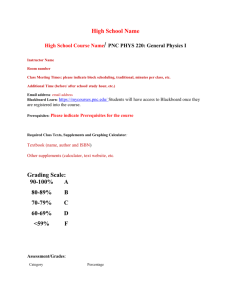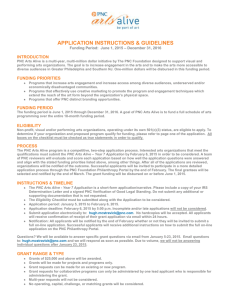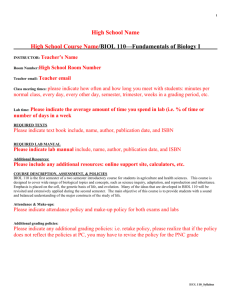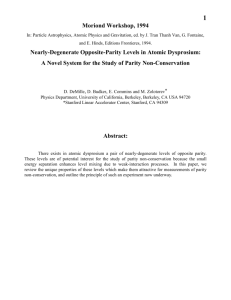jec12164-sup-0001-AppendixS1
advertisement
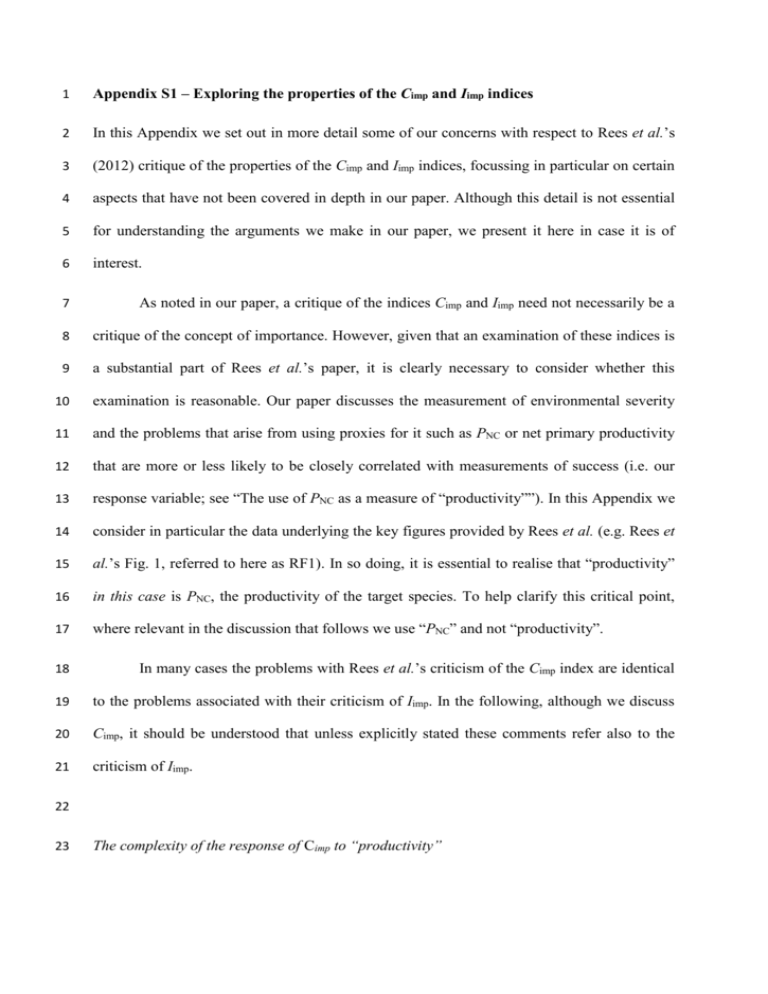
1 Appendix S1 – Exploring the properties of the Cimp and Iimp indices 2 In this Appendix we set out in more detail some of our concerns with respect to Rees et al.’s 3 (2012) critique of the properties of the Cimp and Iimp indices, focussing in particular on certain 4 aspects that have not been covered in depth in our paper. Although this detail is not essential 5 for understanding the arguments we make in our paper, we present it here in case it is of 6 interest. 7 As noted in our paper, a critique of the indices Cimp and Iimp need not necessarily be a 8 critique of the concept of importance. However, given that an examination of these indices is 9 a substantial part of Rees et al.’s paper, it is clearly necessary to consider whether this 10 examination is reasonable. Our paper discusses the measurement of environmental severity 11 and the problems that arise from using proxies for it such as PNC or net primary productivity 12 that are more or less likely to be closely correlated with measurements of success (i.e. our 13 response variable; see “The use of PNC as a measure of “productivity””). In this Appendix we 14 consider in particular the data underlying the key figures provided by Rees et al. (e.g. Rees et 15 al.’s Fig. 1, referred to here as RF1). In so doing, it is essential to realise that “productivity” 16 in this case is PNC, the productivity of the target species. To help clarify this critical point, 17 where relevant in the discussion that follows we use “PNC” and not “productivity”. 18 In many cases the problems with Rees et al.’s criticism of the Cimp index are identical 19 to the problems associated with their criticism of Iimp. In the following, although we discuss 20 Cimp, it should be understood that unless explicitly stated these comments refer also to the 21 criticism of Iimp. 22 23 The complexity of the response of Cimp to “productivity” 24 Rees et al. illustrate much of their critique of the Cimp index in RF1. Close examination of 25 RF1 and associated text helps us to understand some of the assumptions lying behind this 26 critique, and in so doing leads us to question it. 27 First, RF1a presents some hypothetical relationships between C and PNC, which are 28 then used in RF1b to explore some of the characteristics of Cimp. Because C= PNC /PC, and we 29 know both PNC and C (from RF1a), we can then calculate PC (Fig. S1). Being able to 30 visualise PC as well as C and PNC allows us to assess whether the responses of Cimp shown in 31 RF1b are “more complex than the underlying patterns it seeks to summarize”. We would 32 suggest that the patterns in the raw data are not themselves simple, but that their summation 33 in RF1a using the derived ratio C make them appear simple, such that RF1b in contrast 34 appears complex, thereby lending weight to the argument that Cimp is somehow a difficult 35 index to understand. 36 In addition the ratio C is itself not intuitive: assuming a negative effect of neighbours, 37 competition will not be measured as a reduction in performance relative to plant performance 38 alone, as usually is the practice, but rather as a value larger than one. The difficulties with 39 interpreting C are even greater when considering facilitation. In extreme cases in which 40 plants depend on neighbours for their success (e.g. in arid ecosystems) and when PC>>PNC, C 41 then approaches 0. This measurement of biotic interactions therefore has an asymmetric 42 range of values for the two types of plant interactions: while it is highly restricted in the case 43 of facilitation (0<C<1), its range in the case of competition is unlimited (1<C<∞). 44 Examination of the raw data - as opposed to C - helps us to realise that the relationships 45 between Cimp and PNC shown in RF1b are understandable. If we consider first the dashed line 46 (C=2 in RF1a), this represents a case where PC increases linearly with PNC. In this case RF1b 47 usefully demonstrates the relationship between PNC and Cimp as PNC increases, and we see 48 that Cimp is constrained toward PNC when PNC either approaches Pmax, in which case Cimp 49 approaches 1, or as PNC approaches 0, in which case Cimp approaches 0 as well. To us such 50 constraint seems logical. When PNC is 0, how can Cimp not be 0 (and, indeed, how can C=2)? 51 When PNC = Pmax, it is clear that the only factor constraining plant success (P) is competition, 52 and so how can Cimp not be 1 (i.e. how can competition not be 100% of the impact of the 53 environment on plant growth)? However, although there is clearly constraint in the 54 relationship between Cimp and PNC, it is essential to remember that this does not demonstrate 55 that Cimp shows an inevitable relationship with environmental severity: this conclusion 56 depends on how environmental severity is expressed (e.g. as PNC, as NPP, or as a measure of 57 the abiotic environment such as water availability). 58 The dotted line in RF1a shows a rapid decrease in C with increasing PNC (note that the 59 apparent rapidity of this decrease is to some extent dampened by the use of a log scale). For 60 this to occur, PC must initially be incredibly small whilst PNC increases rapidly. This line 61 therefore represents a situation where, when there is a huge reduction in plant performance 62 due to the abiotic environment (i.e. PNC <<Pmax), competition is then also impacting much 63 more severely on the plant. However, despite C being very large when PNC is low, the 64 reduction in performance due to competition is still relatively small in comparison to the 65 absolute reduction in performance due to the total impact of the environment (Pmax-PNC). 66 Consequently Cimp is small. As PNC increases, PC then increases, eventually approaching PNC 67 when PNC approaches Pmax. Whilst PNC is < Pmax, competition still represents a smaller 68 proportion of the total impact of the environment, but as PNC approaches Pmax the only 69 limiting constraint on plant performance is competition, and consequently Cimp approaches 1. 70 The solid line shows a situation where C is initially very low, but then increases as 71 PNC increases, and approaches Pmax. If competition is most influential at low levels of 72 severity (where we assume PNC ≈ Pmax) then the relationship shown is again understandable: 73 at lower levels of PNC, competition is initially unimportant (C is small). Competition becomes 74 increasingly important and hence Cimp approaches PNC as PNC increases, but as PNC is still 75 less than Pmax competition is clearly not the only factor influencing plant success, and so Cimp 76 only equates to Pmax when Pmax = PNC. 77 In all these cases, we suggest that the responses of Cimp to variation in PNC as shown 78 in RF1b make logical sense if we view the data for PC as well as C, and we also suggest that 79 the apparent simplicity in RF1a, and its contrast to the “complexity” of RF1b, belies 80 complexity in the raw data used to calculate the apparently simple patterns of RF1a. 81 However, this discussion does help to clarify the differences between absolute (C) and 82 relative (Cimp) measures of competition. Whether these measures then make biological sense 83 can only be tested by exploring their relationship with measures of plant success and 84 community structure. 85 Finally, we return to the statement by Rees et al. concerning RF1b, especially the 86 expression of severity as productivity, and more specifically as PNC. From RF1a and RF1b, 87 Rees et al. conclude “Therefore, in general, we expect Cimp to increase with productivity 88 regardless of whether effects of competition, C, increase, decrease or are independent of 89 productivity.” It is worth stating again that what we are exploring in these figures (RF1a and 90 RF1b) is not the relationship between Cimp and severity (assumed to equate to productivity) in 91 general, but between Cimp and PNC. Clearly PNC and Cimp have a strong relationship, but as 92 PNC is one of the variables used to calculate Cimp it is not surprising that they are related. 93 If we accept the argument that for many studies and research questions PNC is not 94 used as the measure of severity, we cannot then use the relationship between PNC and Cimp to 95 assess the relationship between Cimp and severity. This is critical: much of the criticism of 96 Cimp, for example it’s inevitable decline in response to changes in severity, or the possibility 97 of approximating it using PNC /Pmax, is based on the assumption that PNC = productivity = 98 severity. We suggest this is potentially one of the most confusing points throughout this 99 debate. 100 101 Selection of random data 102 RF1c illustrates the randomly generated data used by Rees et al. to assess the relationship 103 between Cimp and “productivity” (i.e. environmental severity) in RF1d, from which Rees et 104 al. conclude that “we again find a strong positive relationship between Cimp and productivity 105 (Fig. 1 c, d)”. First, and as noted above, “productivity” is actually PNC, and productivity may 106 itself not be a good proxy for the ideal explanatory variable of environmental severity, so 107 conclusions about the relationship between Cimp and “productivity” must be seen in this 108 context. 109 Furthermore, and independent from this first point, the approach to selecting data for 110 this assessment is biased such that it suggests even random data produce a direct, simple 111 linear relationship between Cimp and PNC. The reasoning behind this second point is set out in 112 some detail in our paper (see The use of C as an index of competition). Briefly, for any given 113 value of PNC, as C increases away from 0 any increase in C has a much smaller impact on PC 114 (Fig. S2a). Consequently, generating a uniform distribution of C between 1 and 100 results in 115 a non-uniform distribution of PC such that in general PC << PNC. If we repeat the production 116 of RF1c, but use the resulting data to plot PC and C against PNC, we can see that the resulting 117 distribution of PC is strongly biased, such that PC tends to be very small irrespective of PNC 118 (Fig. S2b). 119 The obvious consequence of using data where PC << PNC, is that Cimp will inevitably 120 be found to approximate PNC (as in RF1d). A better approach is to randomly generate values 121 of PC. PC should be free to vary between 0 and PNC at any given point along the gradient of 122 PNC. If we redraw RF1c and RF1d, but using randomly generated values of PC selected from 123 a uniform distribution between 0 and PNC, first we see that C tends to be small (Fig. S3a). We 124 suggest this is reasonable as in many cases, particularly when PNC << Pmax, the impact of 125 competition is likely to be limited. Second we see that there is variability in Cimp away from 126 PNC. From these data (Fig. S3a, b) we cannot conclude that “the expected relationship 127 between Cimp and productivity is… PNC /Pmax, which is a linear relationship with slope 128 1/Pmax”. 129 130 An exploration of relationships using field data 131 The next obvious question is whether in field data values of Cimp occur away from the 132 upper boundary of the potential values. Rees et al. use data from Kadmon (1995) to test 133 whether their conclusions based on synthetic data hold true also for data from field studies. 134 While the work of Kadmon (1995) is highly elegant, for the reasons explained in our paper 135 (see The use of only the data from Kadmon (1995) to explore the Cimp-PNC relationship in 136 field studies) we reject it as a proof that Cimp can be simply calculated from PNC /Pmax. We 137 suggest that it is better instead to consider a number of works simultaneously. As for the data 138 from Kadmon (Fig. S4b1) the data from Belcher et al. (1995) show a strong relationship 139 between PNC and Cimp (Fig. S4a). However, in the data from Reader et al. (1994; Fig. S4c) 140 and Ariza & Tielbörger (2011; Fig. S4d), although PNC and Cimp are clearly related it is not 141 possible to predict Cimp using PNC/Pmax. Although it might be argued that, even in the data of 142 Reader et al. and Ariza & Tielbörger, PNC/Pmax is a reasonable approximation of Cimp, the use 1 The analyses by Brooker & Kikvidze (2008) used the data from Kadmon (1995) provided at http://esapubs.org/archive/ecol/E080/006/. In these data, from which Fig. S4b has been produced, there are 12 separate points along the productivity gradient. However, in the figures of Rees et al. there appear to be only 8 points along the productivity gradient, with points missing from the least productive end of the severity gradient. Although this does not alter the relationship between Cimp and PNC, which remains strongly linear with the addition of the extra points, it does alter that between PNC and C as shown in RF4c. With the addition of these missing points the relationship becomes far more curve-linear, trending toward the hyperbolic. 143 of PNC/Pmax to approximate Cimp hides some important information. Perhaps Rees et al.’s 144 analysis is helpful in highlighting that in some data Cimp is closely related to PNC (i.e. the data 145 of Kadmon and Belcher et al.), whereas in others it is not (i.e. the data of Reader et al.), and 146 we might be able to use this distinction to separate out those situations where competition and 147 strain are or are not interacting. 148 The examination of these data again shows the problems of using PNC as a measure of 149 productivity (and proxy for severity). Data from the study by Kadmon show a strong linear 150 relationship between productivity and Cimp, even when productivity is expressed as g m-2 151 (Brooker & Kikvidze 2008, Fig. 1, Table 1). In addition there is relatively little variation in 152 Cimp away from this line. However, data from two of the other studies show no relationship, 153 (Belcher et al. 1995), or a positive relationship (Reader et al. 1994), but in both cases there is 154 substantial variation in Cimp along the gradients of productivity recorded in the study 155 (Brooker & Kikvidze 2008). To put it another way, there is not an inevitable strong positive 156 linear relationship between Cimp and stand-level productivity in these other two studies, in 157 contrast to the conclusion that we would draw if we used PNC as the measure of productivity. 158 159 Specific inaccuracies in the criticism of Iimp 160 As noted above, the problems associated with Rees et al.’s critique of Cimp (the use of PNC as 161 a measure of productivity; the use of C as a measure of competition, thereby hiding 162 underlying complexity within the raw data) apply also to their criticism of Iimp as 163 demonstrated in RF2 and the associated discussion. Therefore we highlight here only one 164 inaccuracy which is specifically relevant to Rees et al.’s critique of Iimp. Rees et al. state that: 165 “Seifan et al. 2010 explore the properties of their index using plant performance with 166 competitors as a measure of productivity (see their Fig. 1). This is unusual as 167 productivity is usually defined with respect to performance in the absence of 168 competition”. 169 This is an error in the interpretation of Seifan et al. 2010, which might itself results from 170 Rees et al.’s definition of productivity as a measurement of target plant performance. Seifan 171 et al.’s Fig. 1 is presented only to demonstrate a change in the common biotic indices’ values 172 in relation to a systematic change in the effect of neighbours. In theory, this change may be 173 correlated with a productivity gradient. The potential effect of such correlations between 174 neighbour effect and productivity (or other environmental gradients) on the behaviour of Iimp 175 and the other common indices are then explored in Seifan et al.’s Fig. 2. 176 177 Putting the detail back into the broader context 178 Finally, it is necessary to place these detailed discussions back into the broader 179 context of understanding the relationship between the relative role of interactions (their 180 importance) and environmental severity. Here we have addressed what we think are some 181 inaccuracies or misleading aspects in the fine detail of the work by Rees et al.. For example, 182 we have demonstrated that the responses of Cimp to variation in PNC as shown in RF1b make 183 logical sense if we view the data for PC as well as C (see The complexity of the response of 184 Cimp to “productivity”, above). Similarly we have demonstrated that in some cases the 185 relationship between Cimp and PNC may not be related to the relationship between Cimp and 186 stand level productivity (see “An exploration of relationships using field data”, above). 187 But this focus on the fine detail should not distract us from the broader messages as 188 set out in our paper concerning analysis of the relationship between competition importance 189 and environmental severity. We need to take an additional step back and remember, for 190 example, that stand level productivity itself may not be a good indicator of environmental 191 severity for the types of analysis in which we are interested (see “The use of PNC as a 192 measure of “productivity”” in our paper). 193 we hope that the analyses that we have provided in this Appendix have given some 194 insight into why we have concerns regarding some of the detail of the analytical approach 195 used by Rees et al. for assessing the Cimp and Iimp indices, but we would caution against 196 excessive focus on this detail being a distraction from the bigger and perhaps more important 197 points concerning the general concept of importance and approaches to its measurement that 198 are made in our paper. 199 200 Acknowledgements 201 We would like to thank Clara Ariza for permission to use the data shown in Figure S4d. 202 203 References 204 Ariza, C. & Tielbörger, K. (2011) An evolutionary approach to studying the relative 205 importance of plant-plant interactions along environmental gradients. Functional 206 Ecology, 25, 932-942. 207 208 209 210 Belcher, J. W., Keddy, P. A. & Twolan-Strutt, L. (1995) Root and shoot competition intensity along a soil depth gradient. Journal of Ecology, 83, 673-682. Brooker, R. W. & Kikvidze, Z. (2008) Importance: an overlooked concept in plant interaction research. Journal of Ecology, 96, 703-708. 211 Carlyle, C.N., Fraser, L.H. & Turkington, R. (2010) Using three pairs of competitive indices 212 to test for changes in plant competition under different resource and disturbance levels. 213 Journal of Vegetation Science, 21, 1025–1034. 214 Gaucherand, S., Liancourt, P. & Lavorel, S. (2006) Importance and intensity of competition 215 along a fertility gradient and across species. Journal of Vegetation Science, 17, 455- 216 464. 217 Gross, N., Liancourt, P., Choler, P., Suding, K.N. & Lavorel, S. (2010) Strain and vegetation 218 effects on limiting resources explain the outcomes of biotic interactions. Perspective in 219 Plant Ecology, Evolution and Systematics, 12, 9-19. 220 221 222 223 224 225 Kadmon, R. (1995) Plant competition along soil moisture gradients: a field experiment with the desert annual Stipa capensis. Journal of Ecology, 83, 253-262. Lamb, E.G., Kembel, S.W. & Cahill, J.F. (2009) Shoot, but not root, competition reduces community diversity in experimental mesocosms. Journal of Ecology, 97, 155–163. le Roux, P.C. & McGeoch, M.A. (2010) Interaction intensity and importance along two stress gradients: adding shape to the stress-gradient hypothesis. Oecologia, 162, 733–745. 226 Reader, R. J., Wilson, S. D., Belcher, J. W., Wisheu, I., Keddy, P. A., Tilman, D., Morris, E. 227 C., McGraw, J. B., Olff, H., Turkington, R., Klein, E., Leung, Y., Shipley, B., van 228 Hulst, R., Johansson, M. E., Nilsson, C., Gurevitch, J., Grigulis, K. & Beisner, B. E. 229 (1994) Plant competition in relation to neighbor biomass: an intercontinental study with 230 Poa pratensis. Ecology, 75, 1753-1760. 231 Rees, M., Childs, D.A. & Freckleton, R.P. (2012) Assessing the role of competition and 232 stress: a critique of importance indices and the development of a new approach. Journal 233 of Ecology, 100, 577-585. 234 235 236 Seifan, M., Seifan, T., Ariza, C. & Tielborger, K. (2010) Facilitating an importance index. Journal of Ecology, 98, 356–361. 237 Table S1. Summary information from studies used by Rees et al. to support their use of PNC 238 as an indicator of habitat productivity. For each study the table shows: its main aim; brief 239 details of the experimental design; environmental factors investigated; habitat type; definition 240 of productivity used. 241 Study Main goal Main experimental design Neighbour removal experiment in three natural sub-alpine grassland communities Main factors examined Gaucherand et al. 2006 Evaluating variations in competitive intensity and importance along a nutrient gradient Lamb et al. 2009 Evaluating how competitive intensity and importance affect plant community structure Experimental garden communities (mesocosms) in which fertilization level was manipulated Fertilization (which is assumed to regulate productivity levels) is used to create variation in root and shoot competition within communities Productivity is not measured Carlyle et al. 2010 Evaluating the response of competition to variation in resources and disturbances Greenhouse experiments in which water, fertilization, clipping and neighbor presence are manipulated Fertilizer levels (high/low) are used directly in the comparison of different competition indices Productivity is not defined Gross et al. 2010 Test whether the outcome of plant interactions is better explained using individual-based stress measurements than by overall productivity Neighbor removal experiment in four natural communities in sub-alpine grasslands Strain: an individual level response to local abiotic factors. Measured as the deviation of individual performance without neighbors from the optimal performance Above ground standing biomass (g/m2) is directly connected to resource availability and used as a proxy for site productivity le Roux & McGeoch 2010 Examine the response of biotic interactions to an environmental gradient Field sampling, Marion Island Altitude and wind exposure are used as proxies for abiotic severity Standing above ground biomass per year (g/m2), although no analysis is conducted with these values Fertility: nitrogen dilution in grassland canopies during regrowth, based on above ground biomass and N content Definition of productivity NI (Nitrogen Nutrition Index) that correlates with above ground biomass 242 Figure S1. Our approximation of the change in PC associated with the values of C and PNC 243 shown in Fig. 1a of Rees et al. Note that the dash, dotted and solid lines in this figure equate 244 to the three relationships used (and similarly indicated) in Rees et al. 350 300 250 PC 200 150 100 50 0 0 50 100 150 200 PNC 245 246 250 300 350 247 Figure S2. Exploration of relationships between C, PC and PNC. a) Illustration of the impact 248 of variation of C on the associated values of PC. In this example PNC is held constant at 100, 249 and C varies between 1 and 100. As the figure shows, a given change in C results in a much 250 greater change in PC when C is small. When C is large, the response of PC is greatly reduced. 251 b) Relationship between PNC and both C and PC when C is randomly selected from a uniform 252 distribution between 1 and 100. 253 a. PC 100 10 1 0 20 40 60 80 100 120 C 254 255 b. 160 140 120 C and PC 100 80 C Pc 60 40 20 0 0 50 100 150 200 PNC 256 257 250 300 350 400 258 Figure S3. Values for a) C and b) Cimp, in relation to PNC, that result from selecting 259 randomly-generated values of PC (not shown) from a uniform distribution between 0 and PNC. 260 These can be contrasted directly with figures 1c and 1d in Rees et al.. 261 a. 35 30 25 C 20 15 10 5 0 0 50 100 150 200 250 300 350 400 250 300 350 400 PNC 262 263 b. 1.2 1 Cimp 0.8 0.6 0.4 0.2 0 0 50 100 150 200 PNC 264 265 266 Figure S4. Plots of PNC vs. Cimp. Data shown are from three datasets used by Brooker & 267 Kikvidze (2008): a) Belcher et al. 1995, b) Kadmon 1995, c) Reader et al. 1994; as well as d) 268 from the study by Ariza & Tielbörger (2011). In the latter case, because of the large number 269 of negative values of Cimp (facilitation) only data for positive values of Cimp are shown, with 270 filled diamonds and open circles indicating values for Biscutella didyma and Hymenocarpos 271 circinnatis, respectively. b. 1.2 1.2 1 1 0.8 0.8 0.6 0.6 Cimp Cimp a. 0.4 0.4 0.2 0.2 0 0 0 0.5 1 -0.2 1.5 2 200 400 600 800 1000 1200 1400 1600 PNC (seed no.) d. 1.2 1.2 1 1 0.8 0.8 Cimp Cimp c. 0.6 0.6 0.4 0.4 0.2 0.2 0 0 0 -0.2 272 0 -0.2 PNC (Yiso biomass) 0.01 0.02 0.03 0.04 PNC (phytometer rgr) 0.05 0.06 0 0.5 1 PNC (total biomass, g) 1.5 2
